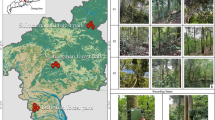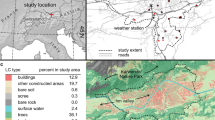Abstract
The urban landscape constitutes a key aspect of human - nature interactions, as more than 60% of the world’s population resides in cities and their suburbs. This study focuses on the characteristics of the landscape that humans (and other organisms) perceive as sound and the role of a suburban soundscape in defining experience of place. Vegetation plays an important role in shaping soundscapes, both by creating sound and attenuating sound from natural and human sources. An invasive insect pest, the Emerald Ash Borer (Agrilus planipennis), is killing millions of ash trees (genus Fraxinus) throughout North America. As a result, many municipalities are systematically removing Fraxinus trees. The objective of this research was to determine if and how removal of a substantial amount of the urban forest in such a community causes changes in the local soundscape, particularly in the proportion of human-sourced sounds versus sounds associated with nature. We selected Arlington Heights, Illinois, as the study site, where a series of before-and-after sound recordings were gathered as ash trees were removed between 2013 and 2015. Comparison of recordings using the Raven sound analysis program revealed significant differences in some measures of sound attributes tested as tree canopy decreased. We detected more human-produced mechanical sounds (anthrophony) and fewer sounds associated with weather (geophony) in these sites. Changes in sounds associated with animals (biophony) varied seasonally. We conclude that monitoring changes in the proportions of anthrophony, biophony and geophony provides insight into fauna biodiversity and the human experience of a suburban ecosystem.













Similar content being viewed by others
References
Alvarsson JJ, Wiens S, Nilsson ME (2010) Stress recovery during exposure to nature sound and environmental noise. Int J Environ Res Public Health 7:1036–1046
Anderson LM, Mulligan BE, Goodman LS (1984) Effects of vegetation on human response to sound. J Arboric 10:45–49
Banzha E, Netzband M (2012) Monitoring urban land use changes with remote sensing techniques. In: Richter M, Weiland U (eds) Applied urban ecology. John Wiley & Sons, Chichester, pp 18–32
Barber JR, Burdett C, Reed SE, Warner KA, Formichella C, Crooks KR, Theobold DM, Fristrup KM (2011) Anthropogenic noise exposure in protected natural areas: estimating the scale of ecological consequences. Landsc Ecol 26(9):1281–1295. https://doi.org/10.1007/s10980-011-9646-7
Beckett KP, Freer-Smith P, Taylor G (2000) Effective tree species for local air quality management. J Arboric 26(1):12–19
Bell S (1999) Landscape: pattern, perception and process. Routledge, New York
Boyer MC (1994) Dreaming the rational city: the myths of American city planning, 5th edn. MIT Press, Cambridge
Brown AL (2010) Soundscapes and environmental noise management. Noise Control Eng J 58:493–500
Brown AL, Gjestland T, DuBois D (2016) Acoustic environments and soundscapes. In: Jian K, Schulte-Fortkamp B (eds) Soundscape and the built environment. CRC Press, Boca Raton, pp 1–16
Brumm H (2006) Animal communication: City birds have changed their tune. Curr Biol 16(23):R1003–R1004. https://doi.org/10.1016/j.cub.2006.10.043
Bucur V (2006) Urban forest acoustics. Springer - Verlag, Berlin, Heidelberg
Cain R, Jennings P, Adams M, Bruce N, Carlyle A, Cusack P, Davies W, Hume K, Plack CJ (2008) Sound-scape: a framework for characterising positive urban soundscapes. J Acoust Soc Am 123:3394–3394. https://doi.org/10.1121/1.2934071
Carson R (1962) Silent spring. Twenty-fifth anniversary edn. Houghton Mifflin Company, Boston
Charif RA, Waack AM, Strickman LM (2010) Raven Pro 1.4 user's manual. Cornell Lab of Orniyhology, Ithaca
Charlton BD, Reby D, Ellis WAH, Brumm J, Fitch WT (2012) Estimating the active space of male koala bellows: propagation of cues to size and identity in a eucalyptus forest. PLoS One 7(9):e45420. https://doi.org/10.1371/journal.pone.0045420
Dramstad OJ, Forman R (1996) Landscape ecology: principles in landscape architecture and land use planning. Island Press, Washington, DC
Dumyahn SL, Pijanowski BC (2011) Beyond noise mitigation: managing soundscapes as common-pool resources. Landsc Ecol 26:1311–1326. https://doi.org/10.1007/s10980-011-9637-8
Dwyer JF, Schroeder HW, Gobster PH (1994) The deep significance of urban trees and forests. In: Platt RH, Rowntree RA, Muick PC (eds) The ecological city: preserving and restoring urban biodiversity. The University of Massachusetts Press, Amherst, pp 137–150
Fan Y, Zhiyi B, Zhujun Z, Jiani L (2010) The investigation of noise attenuation by plants and the corresponding noise-reducing spectrum. J Environ Health 72:8–15
Fang CF, Ling DL (2003) Investigation of the noise reduction provided by tree belts. Landsc Urban Plan 63:187–195
Farina A (2014) Soundscape ecology: principles, patterns, methods and applications. Springer, New York
Farina A, Lattanzi E, Malavasi R, Pieretti N, Piccioli L (2011) Avian soundscapes and cognitive landscapes: theory, application and ecological perspectives. Landsc Ecol 26:1257–1267. https://doi.org/10.1007/s10980-011-9617-z
Frumkin H (2003) Healthy places: exploring the evidence. Am J Public Health 93(9):1451–1456
Genuit K, Fiebig A (2016) Human hearing-related measurement and analysis of acoustic environments. In: Kang J, Schulte-Fortkamp B (eds) Soundscape and the built environment. CRC Press, Boca Raton, pp 133–116
Gilbert J, Dalmont JP, Potier R, Reby D (2014) Is nonlinear propagation responsible for the brassiness of elephant trumpet calls? Acta Acustica united with Acustica 100(4):734–738. https://doi.org/10.3813/aaa.918752
Hall P (1988) The city in the garden, in cities of tomorrow. Basil Blackwell, Ltd, Oxford, pp 87–135
Hartig T, Marcus CC (2006) Healing gardens-places for nature in health care. Lancet 368:36–37
Hawkins D (2012) ‘Soundscape ecology’: the new science helping identify ecosystems at risk. Ecologist 40:5–7
Hough M (1995) Cities and natural process. Routledge, London
Jonnes J (2016) Urban forests: a natural history of trees and people in the American cityscape. Viking Press, New York
Joo W, Gage SH, Kasten EP (2011) Analysis and interpretation of variability in soundscapes along an urban-rural gradient. Landsc Urban Plan 103(3–4):259–276. https://doi.org/10.1016/j.landurbplan.2011.08.001
Kaplan S (1995) The restorative benefits of nature: toward an integrative framework. J Environ Psychol 15(3):169–182
Kaplan R (2001) The nature of the view from home: psychological benefits. Environ Behav 33(4):507–542
Kellert SR (2002) Values, ethics, and spiritual and scientific relations to nature. In: Kellert SR, Farnham TJ (eds) The good in nature and humanity: connecting science, religion and spirituality with the natural world. Island Press, Washington DC, pp 49–64
Kragh J (1981) Road traffic noise attenuation by belts of trees. J Sound Vib 74:235–241. https://doi.org/10.1016/0022-460x(81)90506-x
Krause B (2015) Voices of the wild: animal songs, human din, and the call to save natural soundscapes. Yale University Press, New Haven
Kuppuswamy H (2009) Improving health in cities using green infrastructure: a review. Forum Ejournal 9(December 2009):63–76 Retrieved from http://research.ncl.ac.uk/forum/v9i1/Papers/Kuppuswamy%20(2009)%20Improving%20Heatlh%20in%20Cities.pdf. Accessed 24 May 2010
Laverne RJ, Lewis GM (1996) The effect of vegetation on residential energy use in Ann Arbor. Mich J Arboricult 22(5):234–243
Laverne RJ, Lewis GM (2000) Trees and building energy use. In: Abdollahi KK, Ning ZH, Appeaning A (eds) Global climate change and the urban forest. Gulf Coast Regional Climate Change Council, Baton Rouge, pp 58–69
Li HN, Chau CK, Tang SK (2010) Can surrounding greenery reduce noise annoyance at home? Sci Total Environ 408:4376–4384. https://doi.org/10.1016/j.scitotenv.2010.06.025
Lyle J (1999) Design for human ecosystems: landscape, land use, and natural resources. Island Press, Washington, DC
Marans RW (2003) Understanding environmental quality through quality of life studies: the 2001 DAS and its use of subjective and objective indicators. Landsc Urban Plan 65(1–2):73–83. https://doi.org/10.1016/S0169-2046(02)00239-6
Martínez-Sala R, Rubio C, García-Raffi LM, Sánchez-Pérez JV, Sánchez-Pérez EA, Llinares J (2006) Control of noise by trees arranged like sonic crystals. J Sound Vib 291:100–106. https://doi.org/10.1016/j.jsv.2005.05.030
Matteo M, Randhir T, Bloniarz D (2006) Watershed-scale impacts of forest buffers on water quality and runoff in urbanizing environment. J Water Resour Plan Manag 132(3):144–152. https://doi.org/10.1061/(asce)0733-9496(2006)132:3(144)
Meillère A, Brischoux F, Angelier F (2015) Impact of chronic noise exposure on antipredator behavior: an experiment in breeding house sparrows. Behav Ecol 26(2):569–577. https://doi.org/10.1093/beheco/aru232
Mitchell R, Popham F (2008) Effect of exposure to natural environment on health inequalities: an observational population study. Lancet 372(9650):1655–1660. https://doi.org/10.1016/s0140-6736(08)61689-x
Nassiri P, Monazam M, Dehaghi F, Ghavam Abadi LI, Zakerian S, Azam K (2013) The effect of noise on human performance: a clinical trial. Int J Occup Environ Med 4(2):87–95
Olmsted FL (1995) The Yosemite Valley and the Mariposa Grove of Big Trees: A preliminary report, 1865. Yosemite Conservancy, San Francisco
Pijanowski BC, Farina A, Gage SH, Dumyahn SL, Krause BL (2011a) What is soundscape ecology? An introduction and overview of an emerging new science. Landsc Ecol 26:1213–1232. https://doi.org/10.1007/s10980-011-9600-8
Pijanowski BC, Villanueva-Rivera LJ, Dumyahn SL, Farina A, Krause BL, Napoletano BM, Gage SH, Pieretti N (2011b) Soundscape ecology: the science of sound in the landscape. BioScience 61:203–216
Romero-Garcia J, Clavijo-Garzon S, Bernal MH (2015) The advertisement call of three highland endemic species (Anura: Craugastoridae) from the Andean mountains of Colombia. Zootaxa 4007(2):298–300
Samara T, Tsitsoni T (2011) The effects of vegetation on reducing traffic noise from a city ring road. Noise Control Eng J 59:68–74
Schafer RM (1994) The soundscape: our sonic environment and the tuning of the world. Destiny books, Rochester
Slabbekoorn H, den Boer-Visser A (2006) Cities change the songs of birds. Curr Biol 16(23):2326–2331. https://doi.org/10.1016/j.cub.2006.10.008
Slabbekoorn H, Ripmeester EAP (2008) Birdsong and anthropogenic noise: implications and applications for conservation. Mol Ecol 17(1):72–83. https://doi.org/10.1111/j.1365-294X.2007.03487.x
Southworth MF (1969) The sonic environment of cities. Environ Behav 1:49–70
Sternberg EM (2009) Healing spaces: the science of place and well-being. The Belknap Press of Harvard University Press, Cambridge
Szalma JL, Hancock PA (2011) Noise effects on human performance. Psychol Bull 137:682–707. https://doi.org/10.1037/a0023987
Taylor AF, Kuo FE, Sullivan WC (2002) Views of nature and self-discipline: evidence from inner city children. J Environ Psychol 22(1–2):49–63. https://doi.org/10.1006/jevp.2001.0241
Van Renterghem T, Botteldooren D, Verheyen K (2012) Road traffic noise shielding by vegetation belts of limited depth. J Sound Vib 331:2404–2425. https://doi.org/10.1016/j.jsv.2012.01.006
Von Hoffman A, Felkner J (2002) The historical origins and causes of urban decentralization in the United States, WO2–1. Harvard University, Joint Center for Housing Studies, Cambridge
Wiley RH (2015) Noise matters: the evolution of communication. Harvard University Press, Cambridge
Acknowledgements
The authors would like to thank Mr. Dru Sabatello, Village Forester of Arlington Heights, Illinois for his cooperation and support. Funding for this project was provided in part by the Cleveland State University Office of Research, and the Davey Tree Expert Company.
Author information
Authors and Affiliations
Corresponding author
Rights and permissions
About this article
Cite this article
Laverne, R.J., Kellogg, W.A. Loss of urban forest canopy and the effects on neighborhood soundscapes. Urban Ecosyst 22, 249–270 (2019). https://doi.org/10.1007/s11252-018-0820-4
Published:
Issue Date:
DOI: https://doi.org/10.1007/s11252-018-0820-4




